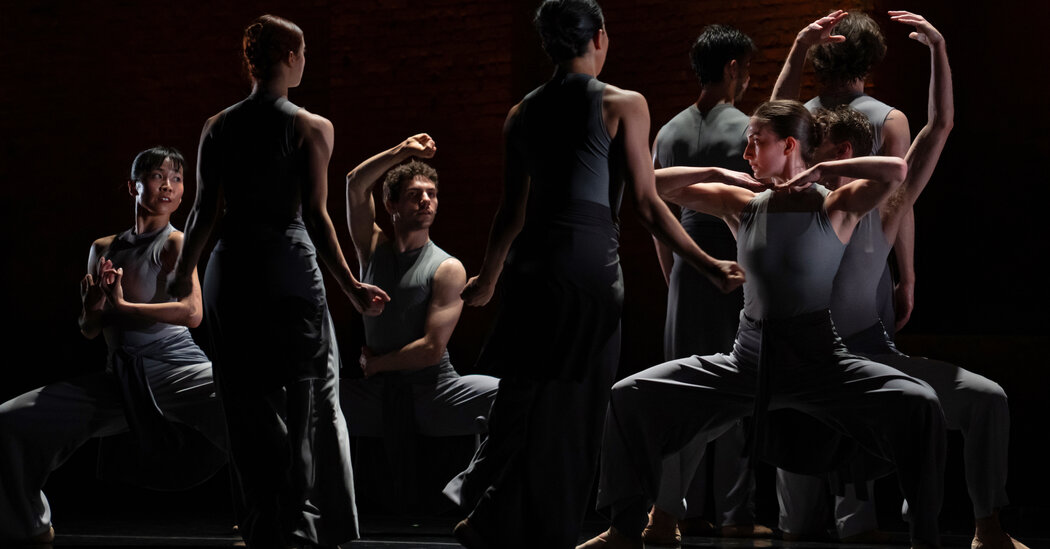Gibney Company puts on dances, as its company director recently said, that deal with what it means to be human. That’s true of any dance — a moving body is alive and therefore human — but as the group’s program at the Joyce Theater showed, there are different ways to convey it. Dances can have feelings, but feelings are not dances.
Unfortunately at this company, led by the founder and artistic director Gina Gibney and the director Gilbert T. Small II, too much repertory champions emotions born from gesture. Its latest program of three world premieres was heavier on feeling and manic movement than on rejuvenating choreographic content.
The exception, unsurprisingly, came from the program’s last piece, “Three Dances (Prepared Piano) John Cage” by Lucinda Childs, who never randomly arranges dancers on a stage, but moves them with formal, mathematical precision. Here, the dancers — or artistic associates, as they are called at Gibney — were transformed as they entered the sleek dance universe of Childs, a revered postmodernist known for her minimal aesthetic.
Choreographing to a John Cage composition, Childs interacts with the music in subtle, playful ways. There even seem to be fleeting nods to Merce Cunningham (Cage’s artistic and personal partner), with whom Childs studied.
“Three Dances” isn’t earth-shattering fare from Childs, but it builds to a satisfying whole. The repetitive patterns aren’t overly complex: Two lines of dancers, eventually skimming the floor with low jumps, switch directions in the first section, while duets fill out the second. In the third, a cluster formation expands to a horseshoe structure and back again. That pulsating formula operates like a heartbeat, and the structure, bound by a jovial, bouncy rhythm, gives the dance room to breathe.
The costumes, simple tops and pants by Karen Young, allow Childs’s strong shapes to etch into the mind — though the shirts tied around waists were distracting — as the choreography contrasted sculptural constellations with gliding sequences. Arms were specific, sometimes bent at the elbows palms up, or slicing a single one diagonally across the body as it hinged forward. But in a work by Childs, potency came in the way the steps and positions linked up and flowed, one into the next, like choreographic streams.
Within the work’s stark formalism, Childs finds a sense of whimsy in Cage’s score and shows it through the interplay between the music and the dance, which builds so that by the final section the dancers open and close in on themselves like petals.
The ease of “Three Dances” was even more apparent given what came before it. At the start of Roy Assaf’s duet “A Couple,” Madi Tanguay stepped in front of a microphone: “Tragically I won’t be dancing this evening,” she said, announcing that she would be performing on May 11. (According to the program, it’s true). She offered an invitation to return to experience her brilliance, as “no one quite does it like I do.”
At least her deadpan lack of modesty is solid. As for the duet, Graham Feeny and Zack Sommer do the honors, zipping their hands and legs through fussy gestural vocabulary to selections by Brahms. It’s a tired formula: moving fast to slow music.
Adapted from Assaf’s full-length “Figure No. 16,” the work looks at a relationship from a confusing perspective that fluctuates between brotherly and romantic devotion. All the while, its supercharged details wear paper thin. Near the end, the frantic action slows as Yair Vardi’s lighting flickers between bright and dark. The dancers, locked in an embrace, roll around the stage and finally stop; abruptly, one rises and walks off, leaving the other behind.
It veers into mawkish territory, but at least it’s short. Peter Chu’s “Echoes of Sole and Animal” is nearly twice as long and even more soupy as cast members, tapping into their animalistic tendencies, blend into the dim sepia environment, which features two openings at the back of the stage for entrances and exits.
There is a kind of self-conscious stab at mysticism throughout “Echoes,” which has a throbbing score by Djeff Houle. At the start, a pair of dancers skid and slide across the stage in shoes, teetering on the edges of their footwear as their bodies turn rubbery. In the final moment, another has a pair of shoes on her hands as she walks offstage with raised hips — picture a downward dog — ever so gingerly.
The dance’s vocabulary veers between slow passages, stretched out and gooey, and groups showcasing fierce unison, in which dancers do things like throw an imaginary ball, swipe their mouths and undulate as if their lives depended on it. The reverberations in “Echoes” are too internal to resonate even when the dancers are clearly, well, feeling all the feels.
Gibney Company
Through Sunday at the Joyce Theater; joyce.org.











